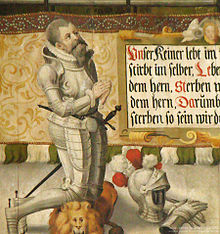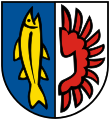Notthhaben (noble family)
Notthaffen is the name of a Bavarian aristocratic family that has been traceable since the 12th century and has been extinct in the male line since 1952 . A relationship to the noble family Nothaft (also Notthracht) von Hohenberg in Swabia is suspected on the basis of circumstantial evidence.
history
Origin of gender
The family tradition traces the origin of the sex back to a Frisian prince Radipold, who marched against Bohemia in the army of Charlemagne and thus came to the Nordgau (Bavaria) . According to Lorenz Fries, the family was first mentioned in a document in 1140 with Rudolf vnd Eilhulf Nothaft , although this document cannot be found and in 1166 with Adalbertus Nothaft .
Distribution in the Egerland
The oldest seat of the Notthafft the north of Eger located Wildenstein Castle , the family called after since about 1220, "Nothaft of Wiltstein". The castle remained in their possession until 1298. In the 13th century Notthafft who founded Castle Sokolov , who are already beyond the eastern border since 1167 the Swabians belonging Cheb region to Bohemian was territory and remained until 1366 in their possession. Family members have been attested as Reichsforstmeister in the Eger Reichsforst since 1310 . As the official seat in this function, they built Thierstein Castle in Thierstein (Fichtelgebirge) , completed in 1340 , which they kept until the end of the 14th century.
The Bavarian main lines Wernberg, Weißenstein and Bodenstein
After their withdrawal from the Egerland , the family spread mainly in the Upper Palatinate and Lower Bavaria. Three main lines emerged:
- The Wernberg Line, named after the Wernberg Castle near Weiden in the Upper Palatinate, which fell to the Notthracht in the 14th century as an inheritance from the Paulsdorf family . She was raised to the status of hereditary imperial count in 1638 with the Reichshofrat Johann Heinrich Notthracht von Wernberg, but died out with his grandson Johann Heinrich Franz Emanuel in 1734. Wernberg Castle had already been sold in 1509. After the end of the Thirty Years' War, Johann Heinrich Notthracht owned Cronheim Castle .
- The Weißensteiner line, whose ancestral seat, today's ruin Weißenstein (Steinwald) , is in the district of Tirschenreuth in the Upper Palatinate, has had the title of baron since the 17th century and died in 1718 with Johann Paul Notthracht von Weißenstein. Already in 1309 Albert Notthaft VI. acquired part of the Weißenstein, Albrecht Notthracht XI. in 1341 also the last third. The rule always remained as inheritance in the possession of the family association, last until 1882 of the Bodensteiner line, and was administered by a carer. Poppenreuth was added in the 14th century , where, however , Poppenreuth Castle was only built after an inheritance was divided in 1541 , which burned down in 1766, and Friedenfels Castle was built around 1590 .
- The third line was initially named after Bodenstein Castle in Bodenstein near Nittenau in the Upper Palatinate , but took the addition of Weißenstein to the name as early as the 16th century. Elevated to the baron status in 1681, this line inherited the Weißensteiner cousins in 1718 and the Wernberg cousins in 1734.
Runding Castle (1721)
Heinrich Notthphia, the Vicedom of the Duke of Lower Bavaria ( Straubing-Holland ), brought Runding Castle into his possession in 1415 through enfeoffment and purchase ; with one interruption, the castle and the associated villages remained in the family's possession for 400 years until 1829.
Finale
In the 19th century, due to the general social upheaval and the precarious financial situation of the family, their last large estates were lost: in 1829 the rule Runding near Cham and in 1882 the rule Weißenstein with the castles Friedenfels and Poppenreuth in the Tirschenreuth district. With Richard August Julius Notthracht Freiherr von Weißenstein, the male line died out in 1952. From 1920 until its dissolution in 1936, he was the last managing director of the Bavarian Central Bank in Munich.
The emergency of Hohenberg in Swabia

In the year 1300, Wernher der Nothafte and his sons Alebrecht and Wernhner appear, the first representatives of the Swabian Nothaft family. A descent of this family from the Bavarian Notthafften can not be proven, but some evidence suggests it. According to the older family chroniclers, the Swabian Nothaft initially sat as Württemberg castle men at Rems or Neckarrems Castle . In 1337 Werner II. Nothaft - the already mentioned son of Werner I mentioned in 1300 - was in the neighboring Hochberg Castle , which from then on became the eponymous seat of the family and remained until it died out. Both Neckarrems and Hochberg have belonged to the municipality of Remseck am Neckar since 1975 .
In the 14th century, Beihingen ( Freiberg am Neckar municipality ) also came into the hands of the family and became the seat of the Beihinger family branch. At the beginning of the 15th century, the Nothaft were an influential family. Werner IV. Nothaft advised Eberhard IV . In 1388 he was involved in a settlement between Eberhard and the Margrave of Baden. In 1425 he donated a benefice and an altar in the Stuttgart collegiate church . Heimaran Nothaft sold the fiefdom in 1532/34 to his brother-in-law Ludwig von Freyberg- Steusslingen.
In addition to Hochberg and Beihingen, the castles of Hochdorf (municipality of Remseck am Neckar), Kleiningersheim (municipality of Ingersheim ) and Oßweil were also owned by the family. Philipp Jacob Nothaft handed over the family property including Hochberg in 1684 to the husband of his granddaughter, Uriel von Gemmingen (1644–1707). He died in 1687 at the age of 90 as the last of his tribe.
Hochberg Castle (gatehouse)
coat of arms
Coat of arms of the Bavarian Notthracht
Blazon : The shield of the coat of arms shows a blue bar on a gold background ; on the helmet two gold buffalo horns covered with blue bars, as a jewel in between a white hound , sometimes with black spots; the ceilings are gold and blue.
Coat of arms history: There are numerous variations of the described coat of arms.
Family coat of arms of those from "Notthracht" from Bavaria, from Scheibler , between 1450 and 1580
Family coat of arms of those of "Nothaft" from Bavaria, from Siebmacher's Wappenbuch , 1605
Marital alliance coat of arms of Elisabetha Nothaftin von Weissenstein (* 1560; † 1582) and Hans Fugger (* 1531; † 1598), from the Fugger's Secret Book of Honor , made in the workshop of Jörg Breu the Younger , 1545–1549
Family coat of arms and portrait of Elisabeth Nothphia von Weissenstein (* 1560; † 1582), wife of Hans Fugger (* 1531; † 1598), from Fuggerorum et Fuggerarum imagines
Extended coat of arms (family coat of arms as heart shield ) of Cajetan Anton Notthracht von Weissenstein , Prince Provost of Berchtesgaden, copper engraving by Chr.Weigel around 1740
Family coat of arms of the von Notthracht (“Dye notthaff / tten”) (bottom left), from the Ingeram Codex of the former Cotta library
Coat of arms of the Swabian Nothaft von Hohenberg
Blazon: The shield of the coat of arms shows two silver eagle wings on a red background; on the helmet between two silver eagle wings is a red pointed cap with a white hermelated cuff , the tip of which is decorated with six black cock feathers.
Family coat of arms of the "Nothaft von Hohenburg [!]" From Swabia, from Siebmacher's coat of arms book , 1605
Family coat of arms of those of "Nothaft" from Swabia, from Scheibler's book of arms , between 1450 and 1480
Family coat of arms of those from “Notthracht” from Swabia, bottom left, from Ingeram Codex , 1459
Coat of arms of the von Notthracht as an element of today's municipal coat of arms
Elements of the coat of arms of the von Notthracht from Bavaria are part of the coat of arms of the former municipality of Birkenbühl , as well as of the municipalities of Runding, Blaibach , Weiding ( district of Cham ) and Friedenfels. The coat of arms of the Nothaft von Hohenberg from Swabia is part of the coat of arms of the municipality of Remseck am Neckar.
Coat of arms of the municipality of Runding
Blaibach community coat of arms
Coat of arms of the municipality of Weiding (district of Cham)
Coat of arms of the community of Friedenfels
Coat of arms of the municipality of Remseck am Neckar
Personalities
- Cajetan Anton Notthannt von Weißenstein (1670–1752): Prince provost of the prince provost of Berchtesgaden
- Heinrich Notthracht von Wernberg (1370–1440), Vicedominus in Lower Bavaria , vault in Hainaut , Holland and Zeeland
- Johann Heinrich Notthracht von Wernberg (1604–1665), Reichshofrat, Reichsgraf and Reichshofratvice-President
- Kunigunde von Nothaft , abbess at Himmelkron monastery until 1370
See also
- List of German noble families
- List of Bavarian noble families
- List of Frankish knight families
- List of Swabian noble families
literature
- Lorenz Fries: Chronicle of the Bishops of Würzburg, fol. 138r
- Genealogical manual of the nobility , Adelslexikon Volume IX, Volume 116 of the complete series, CA Starke Verlag, Limburg (Lahn) 1998, ISSN 0435-2408
- Karel Halla / Volker Dittmar (eds.): Po stopách šlechtického rodu Notthrachtů - Notthrachti v Čechách av Bavorsku - In the footsteps of an aristocratic family - The Notthaffte in Bohemia and Bavaria - Catalog for the exhibition of the same name in the Regional Museum Eger (Cheb) and in the Egerland Museum Marktredwitz, Cheb 2006
- Harald Stark: The Notthracht family - looking for traces in Egerland, Bavaria and Swabia , Weißenstadt 2006, ISBN 3-926621-46-X
Remarks
- ↑ According to information from the Würzburg State Archives, the document from 1140 cited by Lorenz Fries in the Chronicle of the Bishops of Würzburg, in which Rudolf vnd Eilhulf Nothaft is said to appear as a witness, has not survived either in the original or in a copy. So where Lorenz Fries got his information about this entry from cannot be clarified at the moment. The rather rare name Eilhulf does not appear in the Notthracht family either. The year 1166 will probably still have to be considered the year of the first reliable transmission of the family name Notthracht.
- ^ Johann Kaspar Bundschuh: Geographical statistical-topographical lexicon of Franconia. Volume 3. Stettinische Buchhandlung, Ulm 1801, DNB 790364301, Sp. 218-225.
- ↑ Original document with the signature A 601 U 145 in the main state archive in Stuttgart .
Web links
- http://www.notthphia.de
- Coat of arms of the Notthracht in coats of arms of German families , Augsburg 1475
- Coat of arms of the Notthracht in Nikolaus Bertschi's book of coats of arms, especially of German families , Augsburg 1515
- Coat of arms of the Notthracht in the Book of Arms of the Holy Roman Empire , Nuremberg around 1554–1568
- Coat of arms of the emergency of Hohenberg (Swabia) in the register of arms of the Holy Roman Empire , Nuremberg around 1554–1568



























